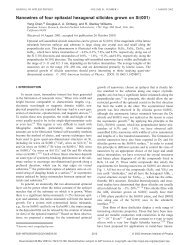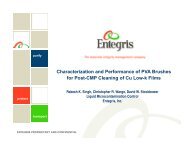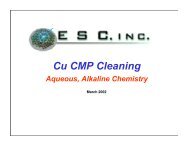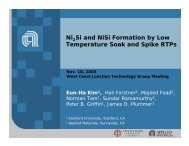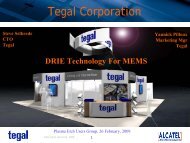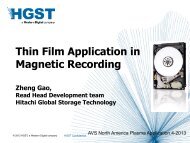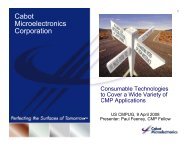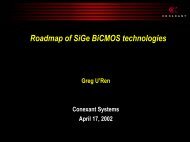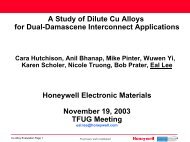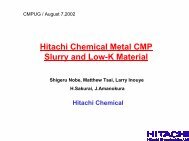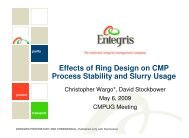Integrated Copper CMP Barrier Slurry Development to Achieve ...
Integrated Copper CMP Barrier Slurry Development to Achieve ...
Integrated Copper CMP Barrier Slurry Development to Achieve ...
Create successful ePaper yourself
Turn your PDF publications into a flip-book with our unique Google optimized e-Paper software.
<strong>Integrated</strong> <strong>Copper</strong> <strong>CMP</strong> <strong>Barrier</strong> <strong>Slurry</strong> <strong>Development</strong> <strong>to</strong><br />
<strong>Achieve</strong> Adjustable Rates and Selectivities<br />
Heather Rayle<br />
Rodel, Inc.<br />
<strong>Copper</strong> <strong>CMP</strong> <strong>Integrated</strong> Solutions
Key Drivers for New Cu <strong>CMP</strong> <strong>Barrier</strong> Slurries<br />
Current and future ICs employ > 6 metal levels requiring high<br />
degree of planarization and <strong>to</strong>pography correction<br />
Non-selective <strong>to</strong> low selectivity barrier slurries are needed <strong>to</strong> correct<br />
<strong>to</strong>pography and planarize<br />
Fabs will require different selectivities <strong>to</strong> correct <strong>to</strong>pography<br />
‣Required selectivity is dependent on incoming wafer <strong>to</strong>pography<br />
from 1 st Step Cu <strong>CMP</strong> process and on the requirements of the<br />
integration scheme<br />
<strong>Barrier</strong> slurry needs <strong>to</strong> balance the removal rates of various films <strong>to</strong><br />
achieve the desired <strong>to</strong>pography, planarization and dielectric loss<br />
targets<br />
CONFIDENTIAL – RODEL, INC. – 8/02
<strong>Development</strong> of Tunable Formulations<br />
Objective: Meet varying cus<strong>to</strong>mer performance<br />
requirements with a tunable family of barrier<br />
slurries with low TEOS:Cu selectivities<br />
Outcome: A model was developed <strong>to</strong> predict nonpatterned<br />
removal rate and pattern <strong>to</strong>pography<br />
data as a function of slurry parameters for the<br />
Politex and IC pad families<br />
‣ Given a cus<strong>to</strong>mer’s removal rate, selectivity, metal loss, ILD loss<br />
and <strong>to</strong>pography requirements, Rodel uses the model <strong>to</strong> predict<br />
which barrier slurries may be most effective in a cus<strong>to</strong>mer’s<br />
process<br />
‣ Testing of the candidate slurries identified by the model allows<br />
Rodel <strong>to</strong> rapidly identify the product that best meets an individual<br />
cus<strong>to</strong>mer’s needs<br />
CONFIDENTIAL – RODEL, INC. – 8/02
Tunable <strong>Slurry</strong> <strong>Development</strong> Model<br />
Models have been developed <strong>to</strong> predict blanket removal rates and<br />
final pattern <strong>to</strong>pography<br />
‣ All slurry components and their interaction/impact on removal rates have been modeled<br />
‣ This model is used <strong>to</strong> predict which barrier slurries may be most effective in meeting<br />
process requirements<br />
1<br />
400 600 Cu RR 800<br />
200<br />
1&3<br />
Component B<br />
4<br />
5<br />
2<br />
6<br />
0<br />
400<br />
600 TEOS RR<br />
800<br />
0 Component A 1<br />
CONFIDENTIAL – RODEL, INC. – 8/02
Predictive Value of <strong>Development</strong> Model<br />
Predicted vs Actual TEOS & Cu RR<br />
900<br />
800<br />
Removal Rate (A/min)<br />
700<br />
600<br />
500<br />
400<br />
300<br />
200<br />
100<br />
0<br />
<strong>Slurry</strong> 1 <strong>Slurry</strong> 2 <strong>Slurry</strong> 3 <strong>Slurry</strong> 4 <strong>Slurry</strong> 5 <strong>Slurry</strong> 6<br />
TEOS RR 517 434 408 488 512 640<br />
Cu RR 428 499 456 434 704 830<br />
Pred. TEOS 625 309 385 492 599 707<br />
Pred. Cu 376 535 423 531 639 746<br />
CONFIDENTIAL – RODEL, INC. – 8/02
<strong>Development</strong> Model Summary<br />
Dishing/Total ILD Loss vs.<br />
TEOS:Cu Selectivity<br />
1000<br />
800<br />
100um 50um<br />
90% 70%<br />
10um 0.25um OF<br />
Dishing/Total Loss (Ang)<br />
600<br />
400<br />
200<br />
0<br />
0.00 0.50 1.00 1.50 2.00 2.50 3.00 3.50 4.00 4.50<br />
-200<br />
-400<br />
-600<br />
Negative values indicate protruding copper<br />
TEOS:Cu Selectivity<br />
CONFIDENTIAL – RODEL, INC. – 8/02
<strong>Development</strong> Model Summary<br />
TEOS:Cu selectivity correlates closely with the degree of feature nonplanarity<br />
observed (dishing)<br />
For the incoming <strong>to</strong>pography generated with Rodel’s 1st step copper process,<br />
minimum final dishing was obtained with a TEOS:Cu selectivity of 1.3-1.4<br />
For TEOS:Cu selectivities well above two, excessive oxide removal results in<br />
protrusion of Cu features above the wafer plane<br />
For TEOS: Cu selectivities below two, the higher copper rate affords<br />
increasing Cu recess as selectivity decreases.<br />
Ta and TaN barrier removal rates can be tuned <strong>to</strong> > 500 Å/min for high<br />
throughput<br />
ILD loss is generally between 100-300 Å after two-step Rodel Cu process<br />
(copper slurry EPL2361 followed by barrier slurry CUS1331)<br />
CONFIDENTIAL – RODEL, INC. – 8/02
CUS1300 Family of <strong>Barrier</strong> Slurries<br />
The CUS1300 family of barrier slurries were developed based<br />
on Rodel’s slurry development models and our understanding<br />
of cus<strong>to</strong>mer performance requirements.<br />
The relative removal rates of the barrier, copper and ILD films<br />
are engineered <strong>to</strong> maintain or improve upon the dishing and<br />
erosion results obtained after the first step process while<br />
minimizing ILD loss.<br />
Multiple slurries within this family of products are available <strong>to</strong><br />
meet the requirements of a specific integration scheme. The<br />
first products commercialized from this family are CUS1331<br />
and CUS1351.<br />
CONFIDENTIAL – RODEL, INC. – 8/02
Attributes of CUS1300 Family <strong>Barrier</strong> Slurries<br />
Reduced erosion/recess vs. 1 st generation products<br />
Low <strong>to</strong>tal metal loss with good dishing<br />
performance<br />
Reduced defectivity<br />
Improved surface quality<br />
Wide process window<br />
CONFIDENTIAL – RODEL, INC. – 8/02
A low selectivity barrier removal slurry family has been<br />
developed with the following features:<br />
Summary<br />
‣ Tunability of the relative removal rates of Cu and dielectric allows<br />
optimization of final wafer <strong>to</strong>pography for a specific cus<strong>to</strong>mer<br />
integration scheme<br />
‣ High barrier removal rates provide high throughput<br />
‣ Significant reduction in <strong>to</strong>pography can be achieved during the barrier<br />
removal step without compromising dielectric loss<br />
‣ Formulations afford low defectivity and excellent surface quality<br />
‣ <strong>Slurry</strong> component interactions are fully modeled <strong>to</strong> allow Rodel <strong>to</strong><br />
predict the best slurry <strong>to</strong> meet a given set of performance<br />
requirements<br />
• Good experimental agreement with model was obtained for both<br />
blanket and pattern wafer responses<br />
CONFIDENTIAL – RODEL, INC. – 8/02
Acknowledgments<br />
Christine Ye, Scientist<br />
John Quanci, R&D Manager<br />
Matthew VanHanehem, Integration Engineer<br />
Terence Thomas, Senior Scientist<br />
CONFIDENTIAL – RODEL, INC. – 8/02



